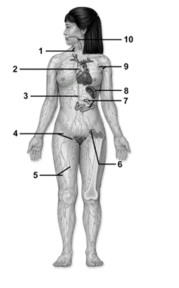A) Jugular lymph sacs
B) Anterior lymph sacs
C) Retroperitoneal lymph sac
D) Cisterna chyli
E) Posterior lymph sacs
Correct Answer

verified
Correct Answer
verified
Short Answer
The process of lymphocyte development and maturation is called ____________.
Correct Answer

verified
Correct Answer
verified
Multiple Choice
Which is not a function of the lymphatic system?
A) Transports dietary lipids
B) Returns excess interstitial fluid to the bloodstream
C) Houses and develops lymphocytes
D) Generates immune responses
E) No exceptions;all choices are functions of the lymphatic system.
Correct Answer

verified
Correct Answer
verified
True/False
The acronym HIV stands for "human immune virus".
Correct Answer

verified
Correct Answer
verified
Multiple Choice
The anteromedial border of the spleen
A) is concave.
B) contains the hilum.
C) is also called the visceral surface.
D) is where the splenic artery enters.
E) All of the choices are correct.
Correct Answer

verified
Correct Answer
verified
Multiple Choice
 -This figure shows the lymphatic system.Which number indicates the inguinal lymph nodes?
-This figure shows the lymphatic system.Which number indicates the inguinal lymph nodes?
A) 1
B) 4
C) 5
D) 9
E) 10
Correct Answer

verified
Correct Answer
verified
Multiple Choice
The thoracic duct and the right lymphatic duct empty lymph into the
A) superior vena cava.
B) subclavian veins.
C) inferior vena cava.
D) azygos vein.
E) brachiocephalic veins.
Correct Answer

verified
Correct Answer
verified
True/False
One of the functions of the lymphatic system is to transport fat.
Correct Answer

verified
Correct Answer
verified
Multiple Choice
The primary goal of the immune response is
A) destruction or inactivation of pathogens and foreign material.
B) maintenance of the proper ionic balance between lymph and blood.
C) stimulation of mitotic activity in order to replace cells damaged by infection.
D) reduction of the number of circulating memory lymphocytes.
E) removal of antibodies from lymph and lymphatic organs.
Correct Answer

verified
Correct Answer
verified
Multiple Choice
What is the function of nurse cells in the thymus gland?
A) Nourish developing T-lymphocytes
B) Transport mature T-lymphocytes to the bloodstream
C) Secrete thymic hormones
D) Destroy moribund T-lymphocytes
E) Transform helper T-lymphocytes into cytotoxic T-lymphocytes
Correct Answer

verified
Correct Answer
verified
Multiple Choice
Which is not correct regarding lymph nodes?
A) They contain strands of lymphatic cells supported by medullary cords.
B) They are drained by afferent lymphatic vessels.
C) They contain phagocytic cells.
D) They filter lymph.
E) None of the choices is correct.
Correct Answer

verified
Correct Answer
verified
Multiple Choice
Where do B-lymphocytes develop immunocompetence?
A) Spleen
B) Red bone marrow
C) Lymph nodes
D) Thymus gland
E) Blood
Correct Answer

verified
Correct Answer
verified
Multiple Choice
Lymphoid stem cells mature into
A) B-lymphocytes.
B) T-lymphocytes.
C) B-lymphocytes and T-lymphocytes.
D) B-lymphocytes,T-lymphocytes,and NK cells.
E) B-lymphocytes,T-lymphocytes,and monocytes.
Correct Answer

verified
Correct Answer
verified
Multiple Choice
T-lymphocytes in the thymus gland do not participate in the immune response and are protected from antigens by
A) the blood-thymus barrier.
B) thymic macrophages.
C) the low pH of the thymus gland.
D) circulating B-lymphocytes.
E) trabecular fibers.
Correct Answer

verified
Correct Answer
verified
Multiple Choice
Of the lymphatic trunks,which ones drain lymph from deep thoracic structures?
A) Jugular trunks
B) Subclavian trunks
C) Bronchomediastinal trunks
D) Intestinal trunks
E) Lumbar trunks
Correct Answer

verified
Correct Answer
verified
Multiple Choice
Within the red pulp of the spleen are enlarged capillaries called _________,which have a discontinuous basal lamina that allows blood cells to enter and exit easily.
A) splenic cords
B) trabecular vessels
C) splenic vessels
D) splenic sinusoids
E) trabecular cords
Correct Answer

verified
Correct Answer
verified
Multiple Choice
What are the five main classes of immunoglobulins found in humans?
A) IgA,IgC,IgE,IgG,IgI
B) IgD,IgE,IgG,IgM,IgS
C) IgB,IgD,IgE,IgG,IgM
D) IgA,IgB,IgC,IgD,IgE
E) IgA,IgD,IgE,IgG,IgM
Correct Answer

verified
Correct Answer
verified
Multiple Choice
Lymphatic capillaries originate in the
A) central nervous system.
B) red bone marrow.
C) yellow bone marrow.
D) tissue spaces between cells.
E) cisterna chyli.
Correct Answer

verified
Correct Answer
verified
Multiple Choice
Which type of lymphocyte responds to multiple antigens?
A) Memory B-lymphocyte
B) Memory T-lymphocyte
C) Natural killer cell
D) Plasma cell
E) Cytotoxic T-lymphocyte
Correct Answer

verified
Correct Answer
verified
Multiple Choice
 -This figure shows the lymphatic system.Which number(s) indicate structures that contain MALT?
-This figure shows the lymphatic system.Which number(s) indicate structures that contain MALT?
A) 1,4,9
B) 2,6,7,8
C) 5
D) 3,5
E) 7
Correct Answer

verified
Correct Answer
verified
Showing 61 - 80 of 90
Related Exams